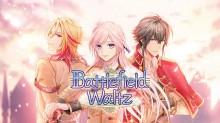Battlefield Waltz (Nintendo Switch) Review
By Nayu  10.04.2025
10.04.2025

Releasing older games is most welcome, especially for titles that never made it outside of Japan for a worldwide release in English. Battlefield Waltz launched on the PlayStation Vita in Japan 11 years ago, in 2014. Published by prolific otome industry giant Idea Factory, alongside the similarly well-known developer Otomate, Nintendo Switch owners can now embark on Lan's adventure with a magic sword at a battle focused academy. Will it match the twists that present day visual novels possess?
Looks are not everything, yet in a video game they matter. Simply looking at the cover indicates the rich colour palette used in Battlefield Waltz. The characters all have a variety of expressions, which add to the realism of the tale, as do the few outfit changes. The movement of them alongside weapon noises in some scenes truly amplifies story immersion. The heroine's name can be changed, but if the default name is retained, it will be spoken by the Japanese only voice actors who voice all dialogue scenes.
Protagonist Lan finds herself in the ward of Nirvana Academy thanks to events in her home village, which result in her being the chosen one of a magical sword that has a spirit inside. This sword is famous, considered a curse to the wielder with all the leaders of nearby nations wishing to be the next to possess it; two of Queen Qiora's allies pay extra attention to the newest student. Being thrust into an elite boarding school environment left Lan with not much time to dwell on the traumatic events that led her there. While closely monitored by the school instructors, participating in classes beats being locked up and viewed like a science experiment.
Set in a military environment, practice battles are routinely participated in, although Lan initially can choose to abstain from them due to various issues with her temperamental magic sword. There are actual external battles, too, since students are sent out whenever a conflict of any kind occurs., with the location depending on which route is being perused.

Annoyingly, no matter the area, the background images for both travel to the skirmish site and the actual location are recycled in every route. Providing a different scene for each place could have added to the variety of cultures hinted at when nearby kingdoms invite Lan and some fellow students for an excursion. The NPCs, including love interests, provide a hint using personality traits and outfits of the type of nation that they belong to.
A major plus of gameplay is the ease of rewinding scenes, or replaying specific scenes from an option in the menu called Chronicle. Here, all routes can be viewed once unlocked, and it shows all side character scenes, too. There are set moments where there is the option to wander around the school and interact with the main characters using three turns, creating a maximum of three chances to elevate affection with love interests or just get to know Lan's platonic classmates.
This is the only time the Chronicle feature can't be used. If a choice doesn't yield an affection increase, it is easy to rewind the scene to where the option takes place using the story log, if one of the 100 save slots wasn't activated for that choice. Separately, scenes can be watched again within Chronicle by merely selecting the order to view a handful of scenes. This must be done from the main title screen, as it won't work while in the middle of playing a route.

Chronicle sadly does not indicate whether a choice is the best one. As already mentioned, some choices increase affection of the heroes, indicated by a coloured flower appearing onscreen. Not every choice has an affection effect, but being a visual novel, presumably all choices have a hidden impact on what ending happens.
There are many bad endings, and particularly unlucky players may spend six or more hours simply trying to get past the bad common ending, which gatekeeps the various routes. Thankfully, it is possible to skip previously read text, but the correct choices need to be made to avoid that abrupt end to the tale in chapter five. The sheer relief from not having the Groundhog Day-type event repeat itself for the zillionth time was almost as palpable as the joy of getting the best endings for a few of the routes. There is a locked sixth route involving the sword's spirit, but Tifalet's best ending was elusive for review, thus the exciting unlocking of said final route wasn't witnessed.
Once away from the common story, each route focuses on the love interests, but all of them have surprises in store. As Lan gets to know each guy, the less public side of their personalities shines through. Without spoiling the tale, one of them acts almost entirely out of personality that makes it unbelievable. There are some overlapping plot points, but the people involved in these changes differ, and that distinct lack of continuity is at times a bit hard to accept when the antagonist's identity is radically different.

Overall, the individual routes are full of unpredictable twists, resulting in Lan needing to make decisions that affect others' lives aside from her own. All five followed routes have an identical end element, which again is unexpected and well done. The number of bad endings encountered before a good ending is impressive. Only in one route were there no bad endings because the best option seemed most obvious. Tifalet's is definitely the hardest to figure out.
The melodious soundtrack is pleasant to listen to even during the many times chapters one through five are endured. It keeps playing at a normal listening rate while the already read text is speedily skipped passed. The fact that set scene music is happily anticipated during the tedious repeated playthroughs prevent the Nintendo Switch Lite being launched across the room at the resulting chapter five bad end, and says a lot about the composition. That and the desire to see what happens in chapters six to nine with characters that are easy to care about. Even the grumpier ones prevent a premature end to the game.
There are absolutely a lot of reasons for post-game play, such as to experience all endings and scenes - even the unpleasant ones. There is even an in-game shop whose currency is achieved at the end of each route, with more given for the better endings. Extra scenes for most characters can be bought with the currency, feeling like a direct reward for all those awful ends (the currency is only given on the first time for each ending, rather than repeatedly given every time that conclusion occurs). Perhaps the difficulty in getting better endings is an aspect of older games that could be changed in future ports to reduce user frustration.

Cubed3 Rating
Great - Silver Award

The anticipated unexpected plot twists combined with highly appealing graphics make Battlefield Waltz a sturdy winner on the Switch. The ease of rewinding scenes and observing which game choices have been selected add to its charm, although enjoyment is marred by how hard it can be to get onto the six routes, as well as even getting a good ending in any of them. This is the sole part that didn't age so well, but hopefully RNG is kinder to the majority of players.

![]() 8/10
8/10
![]() 0
(0 Votes)
0
(0 Votes)
 Out now
Out now  Out now
Out now  None
None  Out now
Out now Comments
Comments are currently disabled

 Sign In
Sign In Game Details
Game Details Subscribe to this topic
Subscribe to this topic Features
Features






 Top
Top

